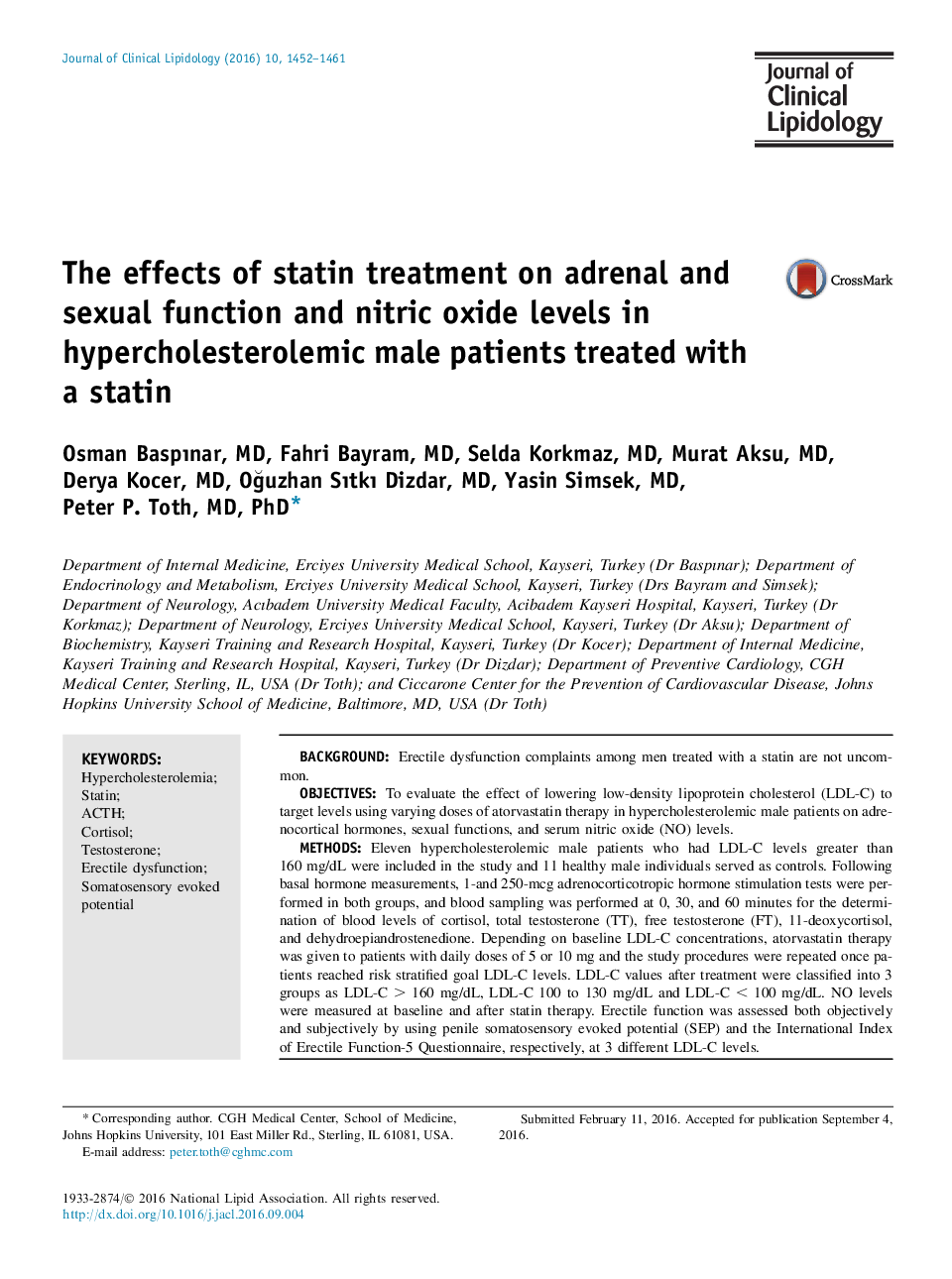| کد مقاله | کد نشریه | سال انتشار | مقاله انگلیسی | نسخه تمام متن |
|---|---|---|---|---|
| 5985145 | 1578169 | 2016 | 10 صفحه PDF | دانلود رایگان |
- Complaints of erectile dysfunction among men treated with a statin are not uncommon.
- We studied the effect of statin therapy on adrenal hormones, testosterone and erectile function.
- Decreased low-density lipoprotein cholesterol levels induced by statin treatment did not impact adrenal hormone levels.
- There was a relationship between low-density lipoprotein cholesterol on statin therapy and total/free testosterone levels.
- These findings will have to be confirmed in a larger number of patients.
BackgroundErectile dysfunction complaints among men treated with a statin are not uncommon.ObjectivesTo evaluate the effect of lowering low-density lipoprotein cholesterol (LDL-C) to target levels using varying doses of atorvastatin therapy in hypercholesterolemic male patients on adrenocortical hormones, sexual functions, and serum nitric oxide (NO) levels.MethodsEleven hypercholesterolemic male patients who had LDL-C levels greater than 160 mg/dL were included in the study and 11 healthy male individuals served as controls. Following basal hormone measurements, 1-and 250-mcg adrenocorticotropic hormone stimulation tests were performed in both groups, and blood sampling was performed at 0, 30, and 60 minutes for the determination of blood levels of cortisol, total testosterone (TT), free testosterone (FT), 11-deoxycortisol, and dehydroepiandrostenedione. Depending on baseline LDL-C concentrations, atorvastatin therapy was given to patients with daily doses of 5 or 10 mg and the study procedures were repeated once patients reached risk stratified goal LDL-C levels. LDL-C values after treatment were classified into 3 groups as LDL-C > 160 mg/dL, LDL-C 100 to 130 mg/dL and LDL-C < 100 mg/dL. NO levels were measured at baseline and after statin therapy. Erectile function was assessed both objectively and subjectively by using penile somatosensory evoked potential (SEP) and the International Index of Erectile Function-5 Questionnaire, respectively, at 3 different LDL-C levels.ResultsWith regard to adrenocorticotropic hormone stimulation test (1 or 250 mcg) results, peak cortisol levels before and after statin treatment among 3 LDL-C groups and among controls did not differ significantly. However, peak TT and FT hormone levels decreased in conjunction with decreasing levels of LDL-C among the statin-treated patients, whereas dehydroepiandrostenedione and 11-11-deoxycortisol peak values did not change. N1 latency obtained during SEP, which is the first negative deflection, was prolonged with decreasing levels of LDL-C and a significant decrease in International Index of Erectile Function-5 scores were observed. When LDL-C levels of ⥠160 mg/dl was reduced to 100 to 130 mg/dl, maximal NO elevations were noted.ConclusionsOur results suggest that decreased LDL-C levels caused by different doses of atorvastatin treatment did not associate with significant changes in adrenal hormone levels. In contrast, there was a significant relationship between attained LDL-C on statin therapy and TT and FT levels. Electrophysiologically, abnormal SEP responses obtained in the patient group with LDL-C levels below 100 indicate a negative impact on the integrity of the somatosensory pathway, which plays a role in erectile function. Reducing LDL-C with a statin was associated with both decreased testosterone levels and erectile dysfunction.
Journal: Journal of Clinical Lipidology - Volume 10, Issue 6, NovemberâDecember 2016, Pages 1452-1461
